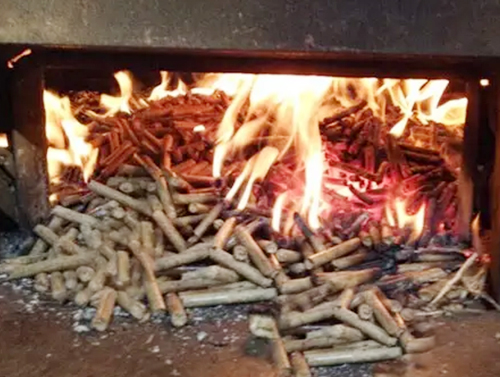Environmentally friendly: Why not just burn logs, wood chips or other biomass feedstocks? One of the reasons is the moisture content. Even the moisture content of air-dried wood tends to be around 30%, while the moisture content of wood pellets is less than 10%. The difference: the smoke from burning particles is significantly reduced. Second, the pellets produce less ash, which is removed during the pelleting process due to soil and bark, etc. Third, and most importantly, energy density. The energy density of wood pellets is more than 3 times greater than that of wood chips. This greatly reduces storage requirements, allowing more fuel to be transported in a given truck space, taking up less storage space. Finally, preprocessing of the particles is straightforward. Its uniform shape and size allow for smaller and simpler feeding systems, reducing costs. This high density and uniform shape can be stored in standard silos, delivered by railcar and delivered by truck container.

The convenience of particles is reflected in the following aspects:
1. Density: about 650 kg per cubic meter
2. It has the same fluidity as liquid, the best choice for automatic system
3. Can be used for furnaces and boilers
4. Can be used for small and large applications
5. Easy to handle, store and transport
6. Improve the combustion characteristics of raw materials
Sawdust is the most common raw material used to make pellets, as it does not require much pretreatment before entering the pellet mill. Nonetheless, there are other optional ingredients. Choices include wood waste (leftover sawdust, wood shavings, wood peel, etc.), yard waste (grass, leaves, branches, forsythia, wisteria and shrubs), farm waste (corn cob, corn stalks, straw stalks) and other biomass wastes . The agricultural biomass most commonly used to make pellets include: Aloe vera, Miscanthus, switchgrass, spiny thistle, olives, rapeseed, sunflowers, grapes, and citrus fruits.
Characteristics of high-quality particles
In the market for premium wood pellets, "premium pellets" refer to pellets with a very low ash content, such as 0.3%. Quality pellets depend on their mechanical durability and moisture content.
Mechanical durability
Mechanical durability simply refers to the compactness of the particles and the goodness of the mechanism. Dense pellets can better withstand the effects of traffic and burn more efficiently in pellet burners. When the quality granules leave the granulator, its surface should be smooth with few or no cracks. If the granules are cracked and fluffy, it is because there is too much moisture in the granules and there is insufficient compression inside the granulator.
After the premium pellets have cooled, they should look like a colored crayon. The surface of the particles should be smooth and shiny. Relative to others, wood pellets tend to be more lustrous. Most importantly, the particles are smooth and firm. Try hitting the surface of the pellet with a hard object to see if it is intact or if it breaks easily. The length of the particles isn't really that important either. However, if the pellet is too long (greater than 1 inch), it may cause damage to the pellet burner's auger.
Moisture content
The less moisture in the pellet, the more energy available to the pellet burner. However, a certain percentage of moisture is required in the granulation process, and it is essential to keep the moisture content as low as possible if high-quality granules are to be produced. The goal is that the moisture content of the finished pellets is below 10%.
Wood is indeed superior to other widely available raw materials, especially agricultural waste. This is due to the low density of agricultural waste, which increases transportation and storage costs. It has a higher ash content because it contains many elements such as silicon, calcium, potassium, chlorine and sulfur. These minerals appear after crops are fertilized. When burned, crops such as straw tend to leave more slag, a dark substance inside boilers and heat transfer equipment. Chlorine corrodes metals. Although these factors are bad, they can be mitigated by specific boilers and controlled by the amount of fertilizer applied and the timing of harvest.
Premium Particle Testing
As mentioned earlier, high-quality granules have a moisture content of less than 10% and are highly dense. The easiest way to test the quality of pellets is to place them in a glass of water, and if the pellets sink to the bottom, they are dense and resistant to compression. Conversely, if the particles float, they are of poorer quality, lower density, lower mechanical durability, and more likely to break down to produce fines. The second test method is to use a container that can hold at least one liter of water and first determine the weight of the container itself. Fill with pellets and weigh again. Now, fill the container with water and weigh it. Subtract the weight of the container for the two measurements, then divide the weight of the particles by the weight of the water. In the case of high-quality pellets, the result should be 0.6-0.7 kg/l, the specific gravity of the pellet. Specific gravity is a key indicator for judging whether the pellets are produced under the proper pressure. Poor quality granules, if the specific gravity is below 0.6, will easily collapse and produce an excessively high powder.